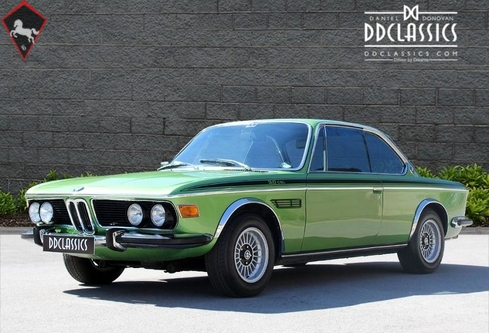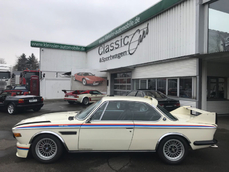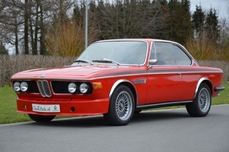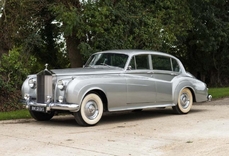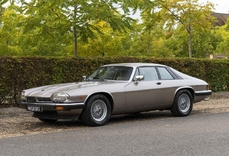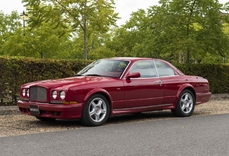BMW 3.0CSL e9 1972
General description :
1 of just 500 RHD cars
426th RHD car
Karmann lightweight coachwork
Former Concours d’Elegance winner BMW car club
Exquisite motoring magazine editorial feature
Matching numbers
Formerly part of a large private collection
1972 BMW 3.0 CSL Former Concours d’Elegance Winner For Sale In London ( RHD )
The early 1970s were landmark years for BMW, for not only did the German manufacturer power Jean-Pierre Jarier to the European Formula 2 Championship, it also captured the European Touring Car Championship using one of the most iconic racing ‘saloons’ of modern times: the 3.0 CSL, known popularly as the ‘Batmobile’.
BMW had returned to six-cylinder power for its range-topping models in 1968 with the launch of the 2500 and 2800 saloons. Also new was the 3.0 CSL’s forerunner, the 2800CS Coupe, though the latter’s running gear had more in common with the existing, four-cylinder 2000C/CS. The introduction of the similarly styled 3.0-liter CS in 1971 brought with it numerous improvements, including four-wheel ventilated disc brakes, and with 180bhp on tap the model was good for around 130mph. For racing purposes, there was also the lightweight 3.0 CSL.
Visually indistinguishable from its more ‘run of the mill’ relations, (the CS and CSi) the 3.0 CSL (Coupe Sport Leicht) was creative homologation at its best. The BMW engineers’ solution to the marketing department’s requirements was to develop a limited production run ‘homologation special’ to meet the constrictive framework of the Group 2 racing class regulations. By removing the trim; using thinner steel for the main body-shell; aluminium alloy for the doors, bonnet and boot lid; and Perspex for the side windows, a valuable 300lbs (136kgs) in weight was saved – ‘Leicht’ indeed.
Homologated initially with a fractionally over-bored (3,003cc) engine (enabling it to compete in the over 3-litre class) the 3.0 CSL came with 206bhp for road use and well over 300 horsepower for the track. In 1973, the engine’s stroke was increased, upping capacity to 3,153cc (nominally 3.2 liters) and from mid-season onwards the racing CSLs used the so-called ‘Batmobile’ aerodynamic package, developed at Stuttgart University, which consisted of a front chin spoiler, large rear wing, and other various devices. Illegal for road use in Germany, the wings were left in the boot for final installation after purchase.
Thus equipped the Batmobile’s were able to defeat the previously all-conquering Ford Capri RS2600s.
Our very god friend, Toine Hezemans captured the 1973 European Touring Car Championship for BMW at the wheel of a 3.0 CSL and co-drove one to a class win at Le Mans that year with Dieter Quester. Ford bounced back in 1974 but from 1975 onwards the BMW ‘Batmobiles’ won five consecutive European Touring Car Championships, a quite unprecedented run of success.
Beautifully finished in Taiga Green metallic coachwork with contrasting Black original Scheel seats and a period Blaupunkt radio cassette. The car is 1 of a total of 1039 combined LHD & RHD cars manufactured by Karmann for BMW and is car number 426 of 500 RHD supplied new via Park Lane BMW London to Mr Dennis Spight of Kent. The car stayed in Mr Spight’s ownership for next seven years.
Being one of the original ‘City package’ cars it has the factory fitted chrome bumpers, softer sports suspension, electric windows, radio cassette and Scheel sports seats. The car was later acquired by Mr C. Holliday, it was during his ownership the car underwent significant cosmetic and mechanical works. Once completed the CSL entered into the world of Concours where it won best in class at the 40th anniversary BMW Car Club held at Longleat House. The following year it was exquisitely featured in a motoring magazine with a four page editorial.
Coming complete with a wealth of invoices spanning 40 years, the complete tool set, owners manuals, press cuttings, magazine editorials, together with details of awards and accolades awarded to the car. This is a special opportunity to buy a true icon of the 70’s.
Now available for viewing at the DD Classics Dealership in London, please call for more information.
http://ddclassics.com/car-listing/bmw-3-0-litre-csl-rhd/
1972 BMW 3.0CSL e9 is listed sold on ClassicDigest in Surrey by DD Classics for £119950.
Car Facts
Car type : Car Make : BMW Model : 3.0CSL e9 Engine size : 0.0 Model Year : 1972 Sub type : Coupé Location : Surrey
Sold
Seller Information
Sold
People who viewed this BMW 3.0CSL e9 also viewed similar BMW listed at ClassicDigest
Other cars listed for sale by this dealer
About BMW
ChatGPT
Bayerische Motoren Werke, commonly known as BMW, has a rich history dating back to its founding in 1916. Initially established as an aircraft-engine manufacturer during World War I, BMW faced restrictions on aircraft production after the war. In response, the company shifted its focus to motorcycle production in 1923, marking the beginning of its involvement in the automotive industry. Subsequently, BMW entered the world of automobiles in 1928 by producing the DIXI, essentially a licensed version of the Austin 7 from the Austin Motor Company.
In the 1930s, BMW began to establish itself as a manufacturer of elegant and high-performance vehicles. One notable model from this era is the BMW 327, introduced in 1937. The 327 was available as both a coupe and a cabriolet, showcasing the brand's commitment to luxury and style. Additionally, BMW achieved success in sports car racing during this period, particularly with the BMW 328. The 328, which debuted in 1936, became renowned for its performance and aerodynamics. BMW campaigned the 328 in various racing events, including the prestigious Mille Miglia, where the company introduced several aerodynamic specials.
The post-war era proved challenging for BMW, and the company faced financial difficulties that nearly led to bankruptcy. However, BMW managed to recover and rebuild, eventually becoming one of the leading premium automotive brands globally.
As the 1960s unfolded, BMW further solidified its reputation for producing sports-oriented and luxurious vehicles. In 1968, the BMW 2002 was introduced, marking the birth of the "New Class" of compact, sporty sedans. The 2002 gained popularity for its agile handling and performance, laying the foundation for BMW's sporty image.
Moving into the 1970s, BMW expanded its lineup with the introduction of the E9 platform, which included the iconic BMW 3.0 CS coupe. The E9 series showcased BMW's commitment to blending performance and luxury. In 1972, the M1, BMW's first mid-engined sports car, made its debut. The M1 was initially developed as a racing car but later became a road-going model. The M1 laid the groundwork for BMW's high-performance M series.
In the late 1970s, the BMW E24 6 Series was introduced, offering a combination of luxury and performance. The 6 Series included models like the 630CS, 633CSi, and 635CSi, becoming a symbol of sophistication and driving pleasure.
Through these milestones and a commitment to innovation and performance, BMW has evolved into a powerhouse in the automotive industry, maintaining its status as one of the leading premium brands worldwide.
